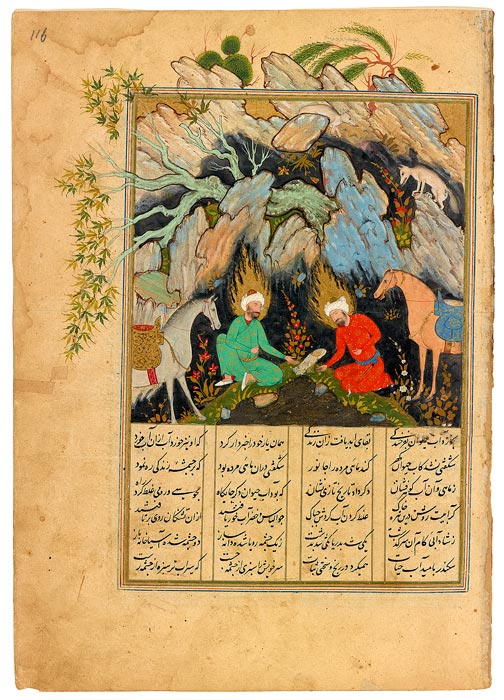
Iskandar (Alexander the Great) and Khiżr, his vizier, set out to reach the end of the world in order to find the Water of Life. They took different paths, however, and only Khiżr found it, achieving immortality. Here he is shown with Ilyās (Elijah). Their dried fish, which accidentally fell into the water, has been miraculously revived. Witnessing the miracle, they achieve prophethood, symbolized by their flaming gold halos. The Prophet Muḥammad reportedly said that Khiżr and Ilyās spend every month of Ramadan in Jerusalem. Khiżr may be the figure on the left, as his name in Arabic means "the green one."
This episode appears in the Iskandarnāma (1194), the fourth poem of the Persian poet Niẓāmī's Khamsa (Quintet).
Persian poetry
The Persians loved their poetry and their poets, though the Qur˒an warned against believing their words (sura 69.41) and "those straying in evil who follow them" (sura 26.224). While Arabic was the first language of Islam and the language of the Qur˒an, Persian was favored by poets. Even Firdausī's (940–1020) celebrated Shāhnāma (Book of Kings), the national epic of Persian, was written in verse—some 50,000 couplets! Rūmī (1207–1273), the best known of the Sufi poets, put poetry in perspective when he wrote, "A hundred thousand books of poetry existed / Before the word of the illiterate [Prophet] they were put to shame!" (Masnavī I, 529). Presented here are illustrations of Firdausī's Shāhnāma as well as works by Sa˓ dī (ca.1184–1292), Hāfiz (ca. 1320–1389), and Jāmī (1414–1492), regarded as the last of the great Sufi poets. Also featured are illustrations from each of the five poems of the Khamsa (Quintet), by Niẓāmī (ca. 1141–1209), especially Lailā and Majnūn (The Persian Romeo and Juliet) and Bahrām Gūr's Seven Princesses.
